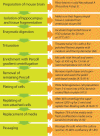A protocol for isolation and enriched monolayer cultivation of neural precursor cells from mouse dentate gyrus
- PMID: 21811434
- PMCID: PMC3140691
- DOI: 10.3389/fnins.2011.00089
A protocol for isolation and enriched monolayer cultivation of neural precursor cells from mouse dentate gyrus
Abstract
In vitro assays are valuable tools to study the characteristics of adult neural precursor cells under controlled conditions with a defined set of parameters. We here present a detailed protocol based on our previous original publication (Babu et al., 2007) to isolate neural precursor cells from the hippocampus of adult mice and maintain and propagate them as adherent monolayer cultures. The strategy is based on the use of Percoll density gradient centrifugation to enrich precursor cells from the micro-dissected dentate gyrus. Based on the expression of Nestin and Sox2, a culture-purity of more than 98% can be achieved. The cultures are expanded under serum-free conditions in Neurobasal A medium with addition of the mitogens Epidermal growth factor and Fibroblast growth factor 2 as well as the supplements Glutamax-1 and B27. Under differentiation conditions, the precursor cells reliably generate approximately 30% neurons with appropriate morphological, molecular, and electrophysiological characteristics that might reflect granule cell properties as their in vivo counterpart. We also highlight potential modifications to the protocol.
Keywords: adult neurogenesis; hippocampus; in vitro; precursor cell; progenitor cell.
Figures




References
-
- Boku S., Nakagawa S., Masuda T., Nishikawa H., Kato A., Kitaichi Y., Inoue T., Koyama T. (2009). Glucocorticoids and lithium reciprocally regulate the proliferation of adult dentate gyrus-derived neural precursor cells through GSK-3beta and beta-catenin/TCF pathway. Neuropsychopharmacology 34, 805–81510.1038/npp.2008.198 - DOI - PubMed
LinkOut - more resources
Full Text Sources
Other Literature Sources

